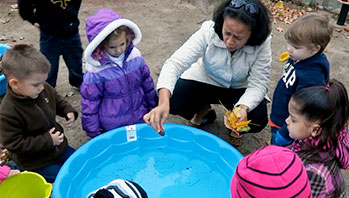- "Sounds We Hear" chart
- tape recorder or other recording device
- different
- listen
- quiet
- same
- soft
- sound
- source
- whisper
MA Standards:
Speaking and Listening/SL.PK.MA.1: Participate in collaborative conversations with diverse partners during daily routines and play.
MA Draft Standards:
Physical Sciences/Energy PS4.A: Investigate different sounds made by different objects and different materials and reason about what is making the sounds. [Cause and Effect]
Head Start Outcomes:
Logic and Reasoning/Reasoning and Problem Solving: Recognizes cause and effect relationships.
PreK Learning Guidelines:
English Language Arts/Language 2: Participate actively in discussions, listen to the ideas of others, and ask and answer relevant questions.
Science and Technology/Living Things and Their Environment 15: Use their senses of sight, hearing, touch, smell, and taste to explore their environment using sensory vocabulary.
Explore Together (outdoors): Outdoor Listening Walk

© Commonwealth of Massachusetts, Department of Early Education and Care. All rights reserved.
STEM Key Concepts: Sounds have a source; Sounds vary in three ways: volume, pitch, and timber; Different objects make different sounds
ELA Focus Skills: Speaking and Listening, Vocabulary
Tell children that they will go outside today and work with a partner as they listen to sounds. Revisit how listening to sounds will help them learn about the world outside.
- Tell children that today, they are going on a listening walk just like the girl and her father in the book The Listening Walk by Paul Showers.
- Explain to children that they will be making a recording of the sounds they hear so they can listen to the sounds again after our listening walk.
Discuss how children will need to walk quietly and whisper if they have something to share with others. Demonstrate talking in a soft whisper as you ask,
- Why do you think it is important to walk quietly and whisper when we are on our walk? Have children respond in a whisper.
Show the recording device and tell children you are going to help them record some of the sounds they hear on their walk. Explain how the recorder works and then demonstrate recording a voice or nearby sound. Then play it back.
- Pair children and go outside.
- Help children use the recorder to record their observations or you may want to tape sounds children hear and request.
Reflect and Share Together
Once back in the room, play the tape and listen to the sounds. Pause after each sound and have partners share what they know about the sound. If partners disagree about the sound ask questions such as,
- What object made this sound? Why do you think so?
If there is a disagreement about the source, have each child explain his or her reasoning. Discuss how it is important to listen to each child’s idea even if you don’t agree with it.
On the “Sounds We Hear” chart, record sounds children heard outdoors. Then use the chart to compare the sounds from the walk with the sounds children heard on their way home. Ask questions such as,
- Did you hear any of the same sounds you heard on your way home last night?
- Did any sound have a different sound than you thought it would?
Social Emotional Tip: Help children understand that working together with a partner can help them learn more by sharing ideas and listening to each other’s observations and questions.
Educator Tip: While recording you may wish to identify each sound, for example, Sound 1, Damon’s sound. Also, pause between each sound. This will help you locate and hear the sounds individually.
